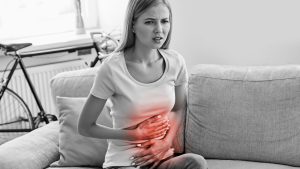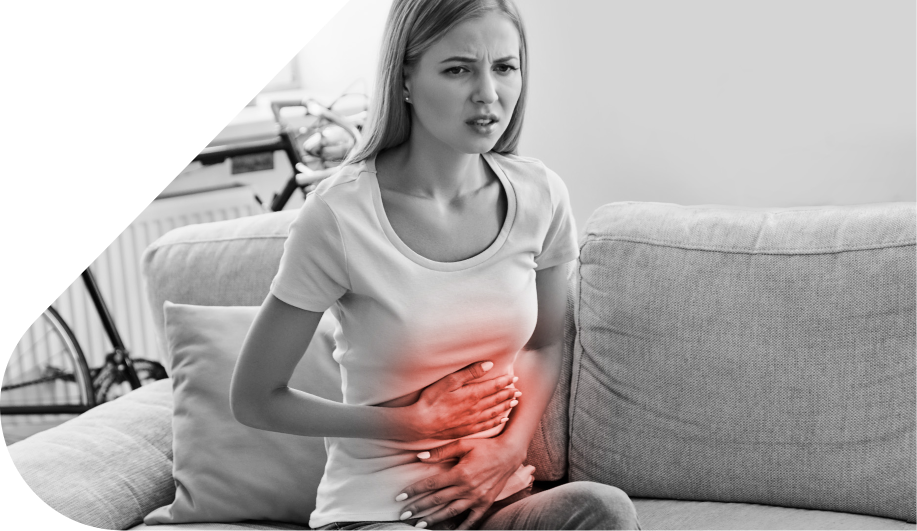Dysmenorrhoea
The term dysmenorrhea (Latin: dysmenorrhoea) generally means pain experienced during the menstrual cycle in women. It begins a few hours before or at the start of menstruation and lasts for one or two days. It is described as spasms
 against a background of constant pain low in the abdomen, which spreads toward the lower back or the front/inner surface of the thighs.
against a background of constant pain low in the abdomen, which spreads toward the lower back or the front/inner surface of the thighs.
Medicine distinguishes two types of dysmenorrhea – primary and secondary. Primary dysmenorrhea occurs when menstrual pain is not associated with any pathological process. It usually appears during the first years after the onset of Secondary dysmenorrhea is menstrual pain that occurs as a symptom of an underlying condition (endometriosis, chronic pelvic inflammatory disease, etc.). It is most commonly observed between the ages of 30 and 45.
Primary dysmenorrhea
The main mechanism of pain onset in primary dysmenorrhea is related to the action of hormone-like substances called prostaglandins. Increased levels of prostaglandins during the menstrual cycle in women lead to contraction of the uterine muscles. The contracted muscles compress the blood vessels supplying blood to the uterine lining, which leads to its “death” and subsequent shedding.
The reduced uterine blood flow caused by the contraction stimulates the release of substances that irritate nociceptors – the nerve endings transmitting pain impulses.
The pain in dysmenorrhea is not an isolated symptom. It is often accompanied by nausea, fatigue, vomiting, diarrhea, headache, and others. Their simultaneous occurrence is explained by the broad-spectrum role of  prostaglandins in the body.
prostaglandins in the body.
The intensity of pain in primary dysmenorrhea is influenced by multiple factors—individual sensitivity, stress and mental tension, insomnia, etc. Usually, after pregnancy and childbirth, the symptoms decrease significantly.
Secondary dysmenorrhea
The onset of dysmenorrhea at the age of over 30–35 is often a symptom of another condition—such as endometriosis, myomatosis (fibroid disease), ovarian cysts and tumors, partial or complete obstruction of the cervical canal, etc.
The seriousness of these conditions requires thorough examination and utmost precision in making the diagnosis. A consultation with a specialist gynecologist is essential, as after the examination, they may order ultrasound imaging, endoscopic procedures—laparoscopy, hysteroscopy, laboratory tests. tests—complete blood count, sex hormone levels, and others. The treatment of dysmenorrhea is determined according to the cause and intensity of the pain. In secondary dysmenorrhea, the priority is to identify and eliminate the underlying condition that caused the pain, while in primary dysmenorrhea, the main focus is on pain relief—most often through medication. The following groups of medications are used:
- Antispasmodics—such as drotaverine and hyoscine butylbromide
- Nonsteroidal anti-inflammatory drugs (NSAIDs)—such as ibuprofen arginine. NSAIDs are particularly effective because they suppress the production of prostaglandins, thus influencing the mechanism of pain onset.
- Oral contraceptives—suppress ovulation and the associated stimulation of prostaglandin production. They are prescribed only by a doctor.
Treatment with NSAIDs follows the principle of using the lowest effective dose, preferably with fast-acting products.
Oklys Express and Oklys Forte contain the active ingredient ibuprofen L-arginine. This formula allows for rapid absorption of the active substance and achieves maximum blood concentration 20 minutes after oral administration. 
Existing studies show that significant pain relief in dysmenorrhea is observed in 82.2% of women at 15 minutes and in 99.2% of patients at 45 minutes after taking 600 mg of ibuprofen arginine.
* Castelo-Branco C. et al. Efficacy and safety of ibuprofen arginine in the treatment of primary dysmenorrhea. Clin Drug Invest 2004 Jul; 24:385-93












